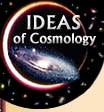
|
|
 |
Circular
Motion Schemes |

|
|
|
A combination
of uniform circular motions could consist of a large circle (the deferent
- Circle DBC with Earth E at its
center), carrying around at constant speed a smaller circle (the epicycle),
which in turn carried around the Planet (P) at a constant
speed. |
||
|
|
||
|
|
||
|
|
||
|
|
||
|
|
||
|
|
||
|
|
||
|
|
||
|
|
||
| Eudoxus
could have, but did not necessarily, account for retrograde motion in the
following manner.
The outer
sphere is not shown in the drawing. Its axis of rotation is vertical,
in the plane of the screen, in a north-south direction. The outer sphere
carries everything within it eastward. The axis of the inner sphere is
horizontal and in the plane of the screen. The motion of a planet carried
about by the inner sphere is up (north) and down (south) and into (west)
and out of (east) the plane of the screen. The planet appears to move
north and west from 1 to 2, north and east to 3, south and east to 4,
and south and west back to 1. When the inner sphere is imparting an eastward
motion to the planet, moving the planet from 2 to 3 to 4, the total eastward
motion, including the steady eastward motion imparted by the outer sphere,
will be very rapid. If the westward speed imparted by the inner sphere
is greater than the steady eastward motion imparted by the outer sphere,
then the planet will appear to slow down and briefly move west during
the passage from 4 to 1 to 2, when the westward velocity of the inner
sphere is greater than the eastward velocity of the outer sphere. Though detailed geometrical models were generated primarily using Platonic two-dimensional circles, it was also possible, at least in principle, to account for such phenomena as the observed retrograde motion of the planets with Aristotelian three-dimensional spheres. Arab astronomers over later centuries continued to refine the Greek schemes. They introduced still more ways to account for the observed planetary motions. To appreciate their ingenuity, see these links to further technical explanations (and animations). |
||
Copyright ©. Brought to you by the Center for History of Physics, a Division of the American Institute of Physics |